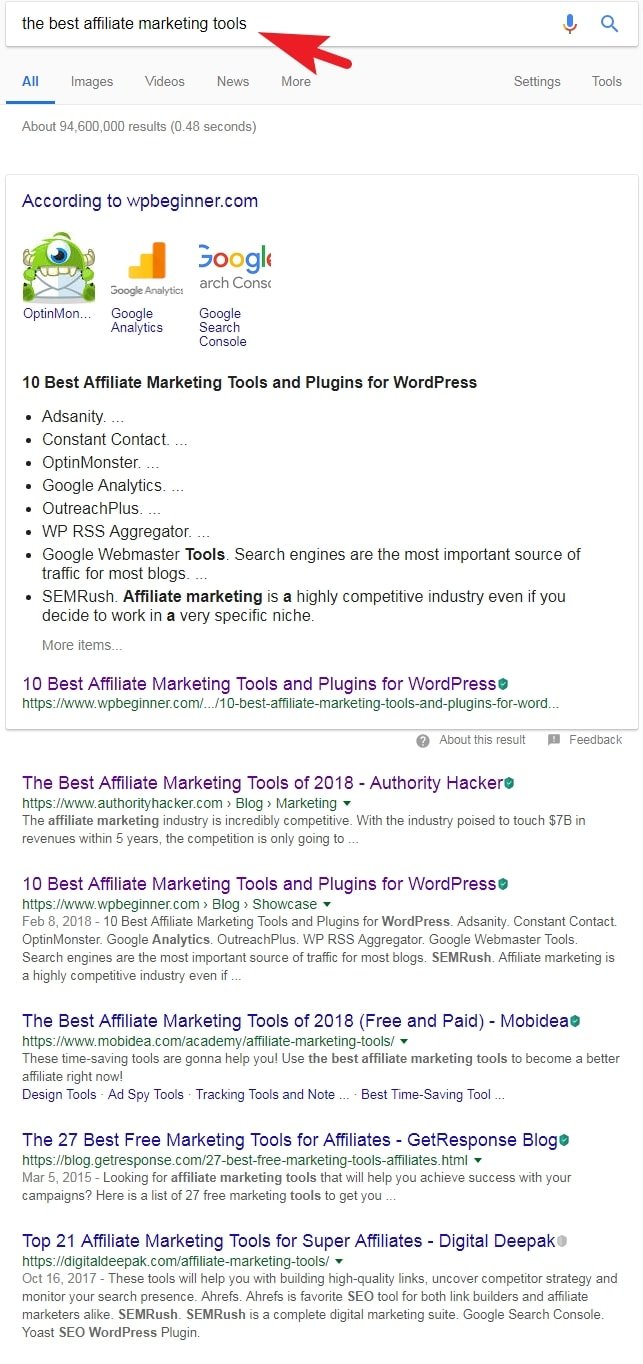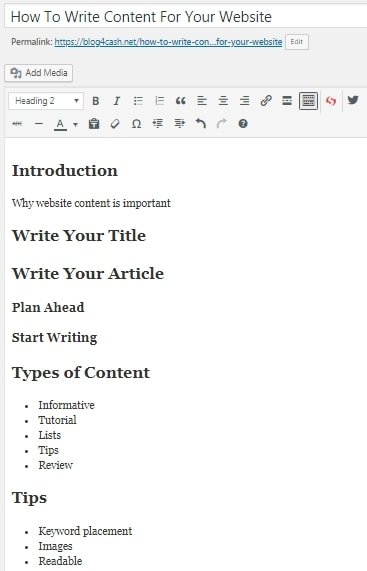If you take a tour around my blog, you will realize that the number of posts on writing content for your website is constantly rising.
This is because your website’s content is the ONLY reason for anyone visiting your website.
Think about this:
Would you ever visit this website or Amazon for anything else besides taking a look at its content?
I guess not…
Well, just like you, nobody is going to visit a website with no content in it.
Now that you have already found your niche, installed and customized your website, learned all about keyword research and employment, all you have to do to start making money is keep filling your website with content.
If you don’t know what I am talking about you might have missed some or all of my previous lessons. If this is the case, please go through all of them before going any further.
You may find all their links right below:
- What is Affiliate Marketing and How It Works. (Lesson #1)
- What is a Niche Marketing Strategy? Finding Your Niche! (Lesson #2)
- Create Your Own Business Website for Free, in Less Than 2 Minutes (Lesson #3)
- How to Set Up a WordPress Website for Beginners (Settings, Plugins, etc)… (Lesson #4)
- Creating Initial Website Content… The Foundation of Your Success! (Lesson #5)
- Fully Customize Your New WordPress Website in a Few Simple Steps! (Lesson #6)
- Keyword Research: The Absolute Beginners How-to Guide (lesson #7)
This is lesson #8 of my affiliate marketing course for beginners.
In this lesson, I am going to take you by the hand and guide you through the process of writing an article for your website.
Before starting writing an article of yours though, there are a few steps that if taken will definitely make your life way easier and the whole process less time and energy-consuming such as
- Determining the type of your content
- Crafting your article’s title
- Planning your post ahead
Let’s get started, shall we?
Determine The Type of Your Content
The first step you should take before writing your article is to determine the kind of article that you are going to be writing.
Some of the most common types of articles that beginner affiliate marketers create are
- Tutorials
- Product Reviews
- “The Best” or “Top” Lists
- Tip Sheets
- Product Comparisons
Let’s find out a little bit more about those types of content.
Tutorial
The sole aim of a tutorial is to teach readers how to do something. A tutorial has to be informative, structured, easy to follow, and as thorough as possible. It must cover everything a person should know about the subject that you are teaching.
99% of the time, the title of a tutorial will begin with the words “How to” such as “How to make lemonade” or “How to boil an egg”.
An example tutorial is this very article, teaching thoroughly how to write content for your website.
Tutorials never go out of style and they are a great way to gain the trust of your reader and capture their email or recommend products that will help them achieve their goals.
Product Reviews
For most affiliate marketers, product reviews are amongst the most lucrative articles of their blog.
This is because people who are looking for a product’s reviews have most likely already narrowed down their decision to a couple of products and they are on the verge of actually purchasing one.
Some of the aspects that are usually covered within a review are the product’s features, usefulness, pros/cons, how to use, personal opinion, etc
The more detailed a review, the easier it will be for a reader to decide if they are going to purchase the product or not, thus saving them time and probably money spent on a crappy similar product.
The products that you are reviewing must always be relevant to your niche.
If your niche is gardening, reviewing a frying pan will be irrelevant, pointless, and even damaging for your business.
It is optimal that you have tried the product you are reviewing yourself for a while. This way, your review is going to be of higher quality, more detailed and objective, and thus more beneficial for your reader.
It’s best practice to always be truthful on your reviews… Don’t try to trick your readers into buying every single product that you are reviewing. If a product is crappy be honest about it and your readers will appreciate you even more.
Video reviews are always the best way to go. Images are the next best thing. If you are not using video on your blog, make sure that you use as many images of the product as possible throughout your review. It would be optimal to include images of you using the product as well.
Check out my Wealthy Affiliate Review to see how detailed, informative, and visual I’ve made it and try to make your reviews even better.
“The Best” or “Top” Lists

“The Best” or “Top” lists are lists that summarize the best of something. This something might be
- products
- ways of doing something
- tools
- services
- training
- etc
I am sure that you have come across tons of such lists online either on Google or on Youtube.
An example list I have created is The 11 Best Affiliate Marketing Tools All Beginners Should Have.
Such lists are very high-converting as you can directly recommend products to your readers or maybe send to some product reviews that you have created. Many blogs live off of just such kinds of lists.
Tip Sheets
Tips are small but very useful and powerful pieces of practical advice, shortcuts, or best practices on a specific subject.
Tip posts are similar to tutorials in many ways.
The main difference is that in a tip post, you are basically teaching your readers how to do something that they already know how to do in an overall better fashion in order to maximize results and achieve their goals faster.
An example tip post is my 12 Awesome Tips to Writing Killer Website Content as a Beginner.
Product Comparison

A product comparison article is basically the same thing as a product review one.
The only difference is that in a product comparison article, you are reviewing two or more products side by side.
This way, you are enabling your readers to instantly compare similar products and make an informed decision on which of those products fits their needs the best, saving them a lot of time, energy, and possibly money.
For those reasons, product comparisons are extremely high converting.
I am actually creating one myself right now comparing Wealthy Affiliate with Affilorama which are the two top-rated affiliate marketing training platforms currently available.
Depending on your niche, some types of content will be more appropriate than others.
For example, an affiliate marketer in the mobile tech niche might benefit more from creating product reviews, product comparisons or top product lists than creating tutorials.
On the other hand, an affiliate marketer in the gardening niche will definitely benefit more from creating tutorials or lists filled with tips and tricks on gardening matters.
Just keep experimenting and see what works best for you.
You could also do a little research on your competition to see what works for them and start following their example.
Craft Your Article’s Title
Now that you have determined the type of your article, it is time to start crafting its title.
Many people prefer doing this after they finish writing their article… I prefer doing it beforehand as it actually helps me stay more focused and to the point. Also, getting it over with in the beginning you have one less thing to worry about.
On our previous lesson Keyword Research: The Absolute Beginners How-to Guide we explained the role of keywords and that the title of every one of our articles should be written around a specific keyword.
For example, this article’s focus keyword is “How To Write Content For Your Website”. This keyword is the first part of the title and it lets the reader know about the information contained in this article.
The second part of my title is “A Must-Read Beginner’s Guide”. This makes my title more specific as it informs the reader that the article is addressed to beginners. Also, the words “must-read” and “guide” make my title attention-grabbing increasing the chances of someone actually reading the article.
Try to make your titles as interesting and specific as possible.
I am going to create a more in-depth article on composing awesome titles later on so make sure to stick around.
Writing Your Content
Okay, now that you have your title ready it’s time to start writing your content.
However, just starting doing so with no plan in mind is going to make your life miserable. This is what I used to do myself until recently.
When I started planning my posts beforehand I found out that
- I experienced better writing flow
- I was able to come up with more content ideas
- My articles got longer and of higher quality
- I was finishing them faster
- My content got way more focused, to the point and effective in helping my readers
Planning out my content before actually starting writing it is way better than starting out of nowhere and trying to find out where to go next during the process.
How To Start Planning Your Articles
The first step to start planning an article is to ask yourself the following question:
“What kind of information is a person after if they query Google for my article’s focus keyword?”
Before answering this question, think about when you type a keyword in Google search and come across several websites offering information relevant to this keyword.
Those websites have created their content by predicting the kind of information you are after when searching for this keyword.
You have to do the exact same thing for your readers.
So, take out a piece of paper and on its top write down your focus keyword.
Below your keyword, start writing down all the things that your reader might be looking for if he searches Google for this specific keyword.
An example:
Focus Keyword -> How to Boil an Egg
Things that my reader might be looking for if they search Google for the term “How to Boil an Egg”:
- What pot to use
- Temperature of water
- Type of heat source
- How much time it takes
- Soft-boiled or hard-boiled
- Cooling
- General tips
- etc
Those points will become the headlines of your article.
Below you can find an image of the initial draft of this article.

Start Writing Your Article
Now that everything is in place you can start composing the flesh of your article.
Elaborating on each headline for 300-400 words will result in a 2000-3000 word article full of information on the subject.
There is no right or wrong way to writing your content. Just try to be as informative and helpful as you can be.
Always remember that at the other end of your article is a human being who is reading it because they need your help.
Some Useful Tips on Writing Your Website’s Content
1/ Place Your Target Keyword Throughout Your Content
As stated earlier, it is mandatory to use your focus keyword in your title.
However, in order to help Google better understand that it should rank your article under your focus keyword, you have to place it in specific parts of your content.
One of the places that your target keyword should be mentioned is in the very first paragraph of your post (see image below).

Note: In the image above, the keyword used in my first paragraph might not be exactly the same as the focus keyword that was used in my title.
However, Google actually understands their relevance and will rank my article accordingly.
After that, mentioning your focus keyword a couple of times in your content should be enough.
If possible and appropriate, mention your keyword in the last paragraph of your article as well.
It is best practice to place your keyword where it sounds the most natural.
Do not force your keyword into your content. Keyword stuffing might hurt your rankings as well as the readability and overall quality of your text.
2/ Use Images
Images make your content way more visually appealing and less tiring. Also, search engines tend to rank articles which contain at least one image higher in the search engine results than those which contain none.
Moreover, articles with images get 94% more total views and are more likely to get shared on social media.
Lastly, images are worth 1000 words. By using images in your articles you get to show your readers and not just tell them. Your readers will appreciate you for that and trust you even more.
Do not stuff your article with images. Use them only when appropriate.
Don’t use random images. Employ images that are helping you tell your story better and make your points stronger such as the infographic that I have used below.
![It’s All About the Images [Infographic]](https://www.mdgadvertising.com/wp-content/uploads/2012/05/its-all-about-images-infographic_475-1.jpg)
Infographic by MDG Advertising
3/ Make Your Content Readable
You might be doing everything else right but if your content is not readable it is definitely going to hurt many aspects of your online business.
If the overall structure of your text sucks and tires your readers they are going to keep leaving probably never coming back.
To avoid this
- Keep your sentences as small as you can(15-30 words maximum)
- Make your paragraphs small as well(1-4 sentences maximum)
- Add white space between your paragraphs(1-2 lines maximum)
- Separate your content with headlines when appropriate
- Write less than 350 words per headline
- Use bullet points and/or numbered lists
4/ Keep it Simple
In my first blog, I used to spend hours on thesaurus (I am exaggerating) trying to find the best and less-known words to use in an attempt to capture my audience’s attention.
Needless to say that nobody really gave a shit about the words I was using.
I have actually come across successful affiliate marketers who made tons of grammatical and spelling errors throughout their content but people kept buying from them… Whaaaat?
Later, I realized that this happened because they were actually focusing more on helping people than trying to decide if they should use the word “blood-pumping organ” instead of the word “heart”.
People are not coming to your business to criticize your writing skills and pay attention to every single word you are using but to get help.
My recommendations
- Use simple, everyday words
- Try to be clear and to the point
- Focus on helping instead of trying to sound smart and sophisticated
5/ You Will Become Better Fast
Most beginners to affiliate marketing, including me, tend to doubt themselves when first starting out.
“My content is not long enough and not good enough.”
“No person will read this and no one will buy from me.”
Those 2 thoughts above, along with thousands of similar ones, are inevitable.
However, something that is inevitable as well, is that you will become better.
When I first started, it took me one week to write a crappy, 300-word article. Now, I can easily write a not so crappy, 2500-word one in just a couple of days.
All you have to do to reach this point yourself is to keep producing content.
Final Thoughts
Always remember that your website’s content is most probably one of the most important factors in your success as a blogger and affiliate marketer.
Keep producing content non-stop… Make sure that your content is as helpful as possible. This is all it takes to eventually succeed.
For further assistance on improving your content writing skills, go ahead and take a look at my 12 Awesome Tips to Writing Killer Website Content as a Beginner.
If you have any questions or need any further help or guidance from me, I encourage you to leave a comment below or email me at harry@dearboss-iquit.com.
You could also drop me a PM on my Wealthy Affiliate Profile.
Whatever the case, I will get back to you as soon as possible.
My best regards to you,
Harry,
dearboss-iquit.com


